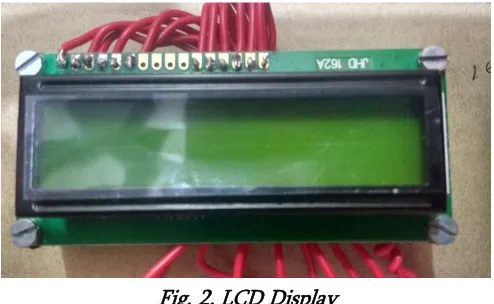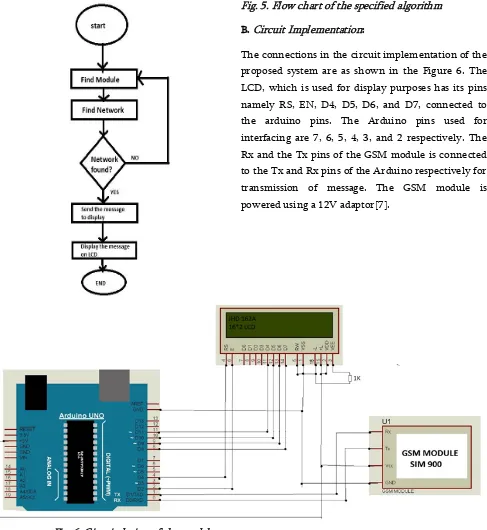© 2018 IJSRCSEIT | Volume 3 | Issue 5 | ISSN : 2456-3307
Wireless Display using GSM and Arduino
Keshav Kumar1, Kumari Ritu2, Mrigangna Singh3, Mangal V.Patil4
1,2,3Student, Electronics Department, College of Engineering, Bharati Vidyapeeth Deemed to be
University, Pune, Maharashtra, India
4 Assistant Professor, Electronics Department, College of Engineering, Bharati Vidyapeeth Deemed to
be University, Pune, Maharashtra, India
ABSTRACT
This paper proposes the idea of a GSM based wireless display system which deals with the issue of reduction of orthodox techniques for large scale display using paper or other methods. It discusses the wireless display on digital notice board using GSM module and Arduino. The project consists of GSM module, Arduino as the microcontroller and an LCD for display. The system is based on real time process and provides a more hassle-free and automated method for mass display. With the world moving towards more and more automation day by day, the proposed system proves to be a boon in the field of mass communication.
Keywords: GSM Module, Arduino, LCD Display
I.
INTRODUCTION friendly factor but also makes it human labour free.In the past scenario, where there was a lack of advanced technologies like wireless communication and automation, the most common method for display at public places was pen and paper. Not only was it a more tedious job, but the consumption and wastage of paper made it environment unfriendly.
Hence this new system was brought as a change to overcome the limitations of the previous techniques. It consists of GSM Modem, SIM, power supply, LCD and arduino. The previous system involved the
process of typing the message in a PC, then transferring it to a USB which was then plugged into a display board to display the message.
Thus, this project takes inspiration from the implementation of wireless communication between a mobile phone and microcontroller. Even in the absence of an authorized person at the location, any message can be displayed anywhere in the world just by sending an SMS from the registered SIM of a mobile phone.
The project finds its application in Smart City Project, public places like hotels, malls, colleges, cinema halls and even home. For instance, one can set the message like “Do not disturb” at one‟s hotel‟s room gate, or at one‟s home‟s door step to display and can send it using mobile phone when away.
II.
LITERATURE REVIEWregarding GSM: its applications, advantages and limitations. It also explains in detail the importance of GSM as the most famous system for the Second Generation mobile telephony all over the world.
2. N.Jagan Mohan Reddy and G.Venkeshwaralu: [2] The authors and their mentioned paper explains a photo type laboratory model wireless notice board system. In this paper the board is connected to a GSM modem which allows the user to display the message on the board using SMS feature.
3. Foram Kamdar, Anubhav Malhotra and Pritish
Mahadik: [3] The paper of the mentioned authors brings forth the environmental friendliness of the proposed system. It lays emphasis on the conservation of time and energy.
4. Shruthi K., Harsha Chawla, Abhishek Bhaduri: [4] The paper presented by these authors
The hardware part consists of ● GSM Modem operator SIM card acts just like a mobile phone with its own unique phone number. The advantage of this modem is that its RS232 pin can be used to
communicate and develop embedded application.[5]. The main operation of the modem is to send or recieve calls or SMS. For this purpose it can be connected to a PC port directly or to any other microcontroller. The GSM modem acts as a highly flexible plug and its direct and easy integration to RS232 applications plays a significant role.
Fig. 1. GSM Module
2. SIM: SIM stands for Subscriber Identity Module. It is a chip-on small card which consists of user's information and phone book. The SIM is inserted in a slot available on the GSM Modem. A SIM card contains a unique serial number (ICCID), international mobile subscriber identity (IMSI) number, security authentication and ciphering information. It also stores temporary information related to the local network, a list of the services the user has access to, and two passwords: a personal identification number (PIN) for ordinary use, and a personal unblocking code (PUK) for PIN unlocking. The SIM used in this project is SIM900A.
Fig. 2. LCD Display
4. Arduino: The microcontroller used in this proposed system is Arduino Uno, shoen in Figure 3, which is based on ATmega328P. It has 14 digital input/output pins (of which 6 can be used as PWM outputs), 6 analog inputs and a 16 MHz quartz crystal. It also consists of a USB connection, a power jack, an ICSP header and a reset button. The main operation of the Arduino is to read the SMS received from the GSM module, extract the main message from the received string and store it in another string. The extracted message is then sent to the LCD display through the commands.
Fig. 3. Arduino UNO
B. Software:
The software used in the proposed project is the Arduino Integrated Development Environment - or Arduino Software (IDE) shown in Figure 4. It consists a text editor for writing the code, a message area and some other common functions. It connects to the Arduino hardware to upload programs and for communication[6].
Fig. 4. Arduino 1.8.5 Programming Interface
IV.
IMPLEMENTATIONA. Software Implementation:
The software implementation, shown in Figure 5, mainly consists of programming using C language. The AT commands are used to operate the GSM modem. AT command, which is used for authentication consists of a message being preceded by „#‟ and followed by „*‟ to indicate start and stop for reading of the message respectively. For example, if the message to be displayed is “Hello”, then it is written as “ #Hello* ” .
Algorithm:
Start
Check for module connectivity
If not connected, find the network.
If network is found, type the message through you mobile phone and send it to display over GSM network.
Check for the message at the receiver side and also the sender‟s authentication.
Fig. 5. Flow chart of the specified algorithm
B. Circuit Implementation:
The connections in the circuit implementation of the proposed system are as shown in the Figure 6. The LCD, which is used for display purposes has its pins namely RS, EN, D4, D5, D6, and D7, connected to the arduino pins. The Arduino pins used for interfacing are 7, 6, 5, 4, 3, and 2 respectively. The Rx and the Tx pins of the GSM module is connected to the Tx and Rx pins of the Arduino respectively for transmission of message. The GSM module is powered using a 12V adaptor[7].
Fig. 6. Circuit design of the model
V. RESULTS
Initially when power is switched on the default message which is displayed is shown in Figure 7.
Fig. 7. Welcome message being displayed
Fig. 8. Message being sent from a mobile device
After transmission and receiving of the message “Hello” it is displayed on the LCD as shown in the Figure 9.
Fig. 9. Message received, displayed on the LCD
V.
CONCLUSIONThe display boards, being one of the major medium for mass communication, must be efficient enough to cater to the public need instantaneously. This project, which is an idea to make use of GSM communication to various fields, can be efficiently implemented in this system. The proposed system proves its mobility by being easily integrated with almost all general purpose display boards. The major advantages of this system is the increased security along with fast communication and environmental friendliness.
VI.
REFERENCES[1] Guifen Gu and Guili Peng, The Survey of GSM Wireless Communication System, International Conference on Computer and Information Application (ICCIA 2010).
[2] N. Jagan Mohan Reddy and G.Venkeshwaralu, Wireless Electronics Display Board Using GSM Technology, International Journal of Electrical, Electronics and Data Communication, ISSN: 2320-2084.
[3] Foram Kamdar, Anubhav Malhotra and Pritish Mahadik, Display Message on Notice Board using GSM ISSN 2231-1297, Volume 3, Number 7 (2013), pp. 827- 832 Research India Publications. [4] Shruthi K., Harsha Chawla, Abhishek Bhaduri,
”SMART NOTICE BOARD”, Department of Electronics and Communication, Manipal Institute
of Technology, Manipal University,Karnataka. [5] Abhishek Gupta, Rani Borkar, Samita Gawas,
Sarang Joshi, GSM Based Wireless Notice Board, International Journal of Technical Research and Applications e-ISSN: 2320-8163.
in Applied Science & Engineering Technology (IJRASET),Volume 3 Issue V, May 2015 ISSN: 2321-9653



